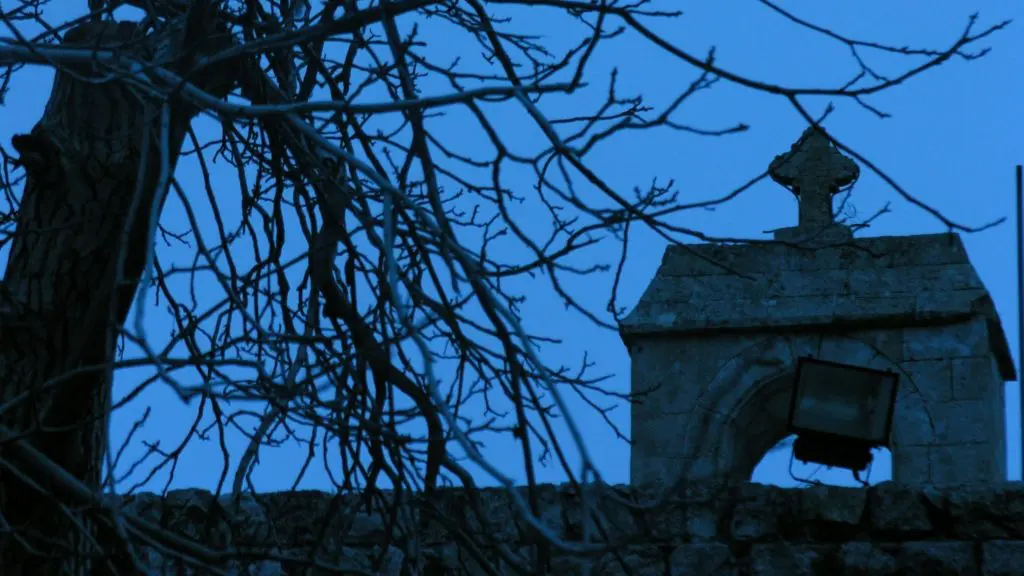Every year, over the course of Advent and Christmas, Westerners are surrounded by seasonal tales. Some of the stories are profound and some are vapid. Some are Biblically rooted and some seem to have sprung from nowhere. Some are told aloud while some are viewed on television. Regardless of the precise form these stories take, they generally aim to communicate something about the meaning of our annual observance of Christmas, the holiday during which Christians celebrate the birth of the Savior of mankind, Jesus Christ, who was born of a virgin in a manger under the watchful protection of the chaste St. Joseph.
While this column usually highlights works that are not widely-known, this month I want to consider a text that many have read, but under an aspect few have encountered. Namely, I’m going to be taking a look at the middle-English work Sir Gawain and the Green Knight as a Christmas poem. (Also unusual: be prepared for a few ‘spoilers’—you have been warned!)
Far too often, Sir Gawain is read merely as a fantastical poem with little attention paid to its festive character. The work is beautiful, yes, and perhaps symbolically fecund, but distinctively Christian? Hardly, say many readers. The poem may begin with the celebration of Christmas and involve chivalric ideals, but the antagonist, the gigantic green monster known as the Green Knight, looks far more like something out of a pagan folk tale than anything the Evangelists Matthew and Luke—who give us the famous Gospel nativity scenes—ever described.
But this approach to the poem represents a sad modern reduction of this great work. Sir Gawain is a dramatic tale of a knight’s bravery and chastity in the face of temptation and, crucially, the distinctive experience of grace and forgiveness that Christ’s birth, death, and resurrection has made possible.
The Green Knight’s challenge
The main narrative begins with a Christmas feast on New Year’s Eve in Camelot. The celebration is a joyful one, and the king, the queen, and many knights and ladies are there taking part. But then a towering, monstrous figure enters the hall. He is a knight, yes, but a knight without armor and whose skin is green from head to toe. The Green Knight, holding an enormous axe, announces that he has come to offer a challenge: any man brave enough can take a single swing at the Green Knight’s head with the axe, and then one year and a day later the Green Knight will have the chance to repay the favor with the same weapon at his chapel.
Surely, the people think, the Green Knight will be decapitated and die if his challenge is accepted. And yet, he is so monstrous—is his skin impenetrable? None of the knights present themselves until finally King Arthur stands up to accept the challenge. However, his nephew Sir Gawain rises and begs to take his king’s place, and Arthur accepts this offer. The Green Knight, bending down, bears his neck, and Sir Gawain lets the blow fall, cutting off the Green Knight’s head. He waits for the body to fall to the floor, but it does not. Instead, the Green Knight picks up his head and mounts his horse. Before departing, he reminds Sir Gawain of his obligation to present himself at the chapel in a year and a day.
The year passes, and—despite encouragement from others to run—Sir Gawain bravely submits to his duty, leaving Camelot and making his way to meet his fate. On his way, the knight is invited to stay in the castle of a kind lord. Sir Gawain attempts to refuse politely, saying that he only has a few days to locate and get to the Green Knight’s chapel, but the lord laughs, saying that it is just a short ride away. Thus, he can accept hospitality for three nights and easily make it to the fateful chapel. With this settled, Sir Gawain agrees to stay, not realizing that his real trial will occur, not when facing the axe, but while staying at this nobleman’s home.
The test of chastity… and honesty
Part of what makes tales of knights perennially appealing is the focus on chivalry. These stories tell us that knights (and, by extension, all men) ought to conduct themselves with honor, keeping themselves chaste and caring for others, especially women and those over whom they have power. In the era of #MeToo and horrifyingly abusive mega-corporations like Amazon, we could learn quite a lot from stories of Arthur’s knights. Even when knights fail to live up to the ideals of their code, they still force us to confront moral questions about how we are living our own lives. In this tale, Sir Gawain’s Christian devotion to the ideals of chivalry is tested, and while it may initially seem as though he passes, on reaching the end of the work it becomes clear that the reality is more complicated. Yet, it is in Gawain’s failure that the tale’s connection to Christmas becomes clearer.
But what is the test? The lord of the castle, a great hunter, makes a friendly deal with Sir Gawain: he will spend the day hunting while Sir Gawain remains at the castle, and they shall exchange their spoils as gifts for one another each evening. The knight happily agrees to this bargain. However, after the lord has left for his hunt, the beautiful and charming lady of the castle, the lord’s wife, enters Sir Gawain’s chamber and attempts to seduce him!
Sir Gawain is caught in a bind: of course, as a chivalrous knight he cannot give in to her brazen advances, but that same code of chivalry mandates that he be gracious to women and avoid exposing them to embarrassment and shame. Thus, after pretending to sleep, he dallies, expertly avoiding the lady’s advances. This is quite fitting, as Sir Gawain was widely known for his chastity, as well as the devotion to the Virgin Mary that helped him stay firm in this virtue. (Indeed, unlike other knights, who adventured in honor of a given courtly lady, Sir Gawain dedicated all his quests to Our Lady.)
In the end, he accepts only a kiss from the woman. When the lord returns, laying the fruits of his hunt before Gawain, the knight responds by giving his host a single kiss. This delights the lord, though the knight refuses to say who gave him the kiss he has passed on. The next day proceeds much the same, with the lady landing two kisses on Sir Gawain and the knight passing both on to the lord. On the third and final day of his visit, the lady is especially brazen, but Sir Gawain passes this text of chastity, accepting just three kisses from the woman, and refusing the constant push for more than a few cordial kisses.
However, he faces a further test. The lady, lovestruck, wants to give Sir Gawain a keepsake. She first offers a ring, which the knight refuses, but then she presents Sir Gawain with a sash that will, she promises, protect him from all harm. He must not tell her husband of the gift, though. Afraid of losing his life to the Green Knight the next day, Sir Gawain accepts the sash.
That evening, when the lord of the castle presents his spoils, Sir Gawain kisses him three times, but he dishonestly fails to hand over the sash. Up to this point, Sir Gawain has acted as a proper Christian knight, staying chaste, honorable, and honest. He is even keeping his promise to the Green Knight! But, out of fear, he keeps the sash in the hope of staving off death. Here, Sir Gawain fails in his knightly duty. While it may seem to be a minor infraction, this failure represents a fall from grace and a departure from the chivalric ideal—which for him are the same thing.
Grace in failure—the Green Knight and Christ
Sir Gawain leaves his host’s home in search of the Green Knight and his chapel. Unsurprisingly, he wears the sash that supposedly grants him invulnerability. Coming upon the Green Knight, Sir Gawain kneels and submits himself to the axe’s blade. After two false starts, the Green Knight brings his weapon down on Gawain’s neck.
Two possibilities occur to the first-time reader: either he loses his head or he is unharmed. If the sash’s enchantment works, the axe will not have any effect on Sir Gawain; but if it is a mere piece of cloth in which he has placed his trust, he will be decapitated. However, the poet takes a third route: Gawain’s neck is hurt, but only very mildly. Suffering little more than a small scratch and knowing their deal has ended, Gawain quickly grabs his sword and armor in case a fight is forthcoming. The Green Knight, however, simply laughs, revealing himself as the lord of the castle at which Sir Gawain has been staying. He explains that the small wound Gawain suffered is in recompense for his failure of honesty.
This, for me, is where the poem’s character as a Christmas story begins to become clear. In a pagan world of harsh justice, Sir Gawain’s small lapse in honesty would be enough to lose him his head. The God of the Christian, however, does not come exclusively as a judge. Instead, he arrives in the world as a defenseless child. Now, it is true that this child will someday return in glory to judge all of humanity, and that judgement will be absolutely final, but He chooses to judge only after having delivered Himself over for our sins.
Sir Gawain is deeply ashamed on hearing the Green Knight’s admonition, just as we all are when confronting our sins with humility. However, the Green Knight, like Christ, does not leave Gawain in his shame. Instead, He commends Gawain for the virtue that he has maintained. After parting, Sir Gawain returns to Camelot and honestly tells the tale of his adventure. The knights forgive him his failure, just as Christ does for all those who come to him with their pain and brokenness.
Thereafter, the knights agree to wear green sashes as reminders to be honest in all their dealings. This choice echoes a profound truth of Christianity: our sins, though grievous, have the potential to stand as great monuments of God’s mercy. Just as the resurrected Christ still has the wounds of the crucifixion, so the sins of the saints in Heaven stand as trophies, each one being forgiven. Just as the knights wear the green sash, so the martyrs are depicted with the weapons that took their lives. Christ gives meaning to our sin and suffering, and the perfection to which we are called is achieved only through God’s own cooperation with our sins.
Sir Gawain and the Green Knight shares one thing in common with all great Christmas stories: it reminds us of the ultimate purpose of Christ’s birth in Bethlehem. His birth, death, and resurrection are intimately connected, and we cannot understand any one without the other two. Christmas must be experienced with an eye towards Good Friday and the paschal feast, just as Easter should be celebrated with the memory of the humble stable and the holy cross.






